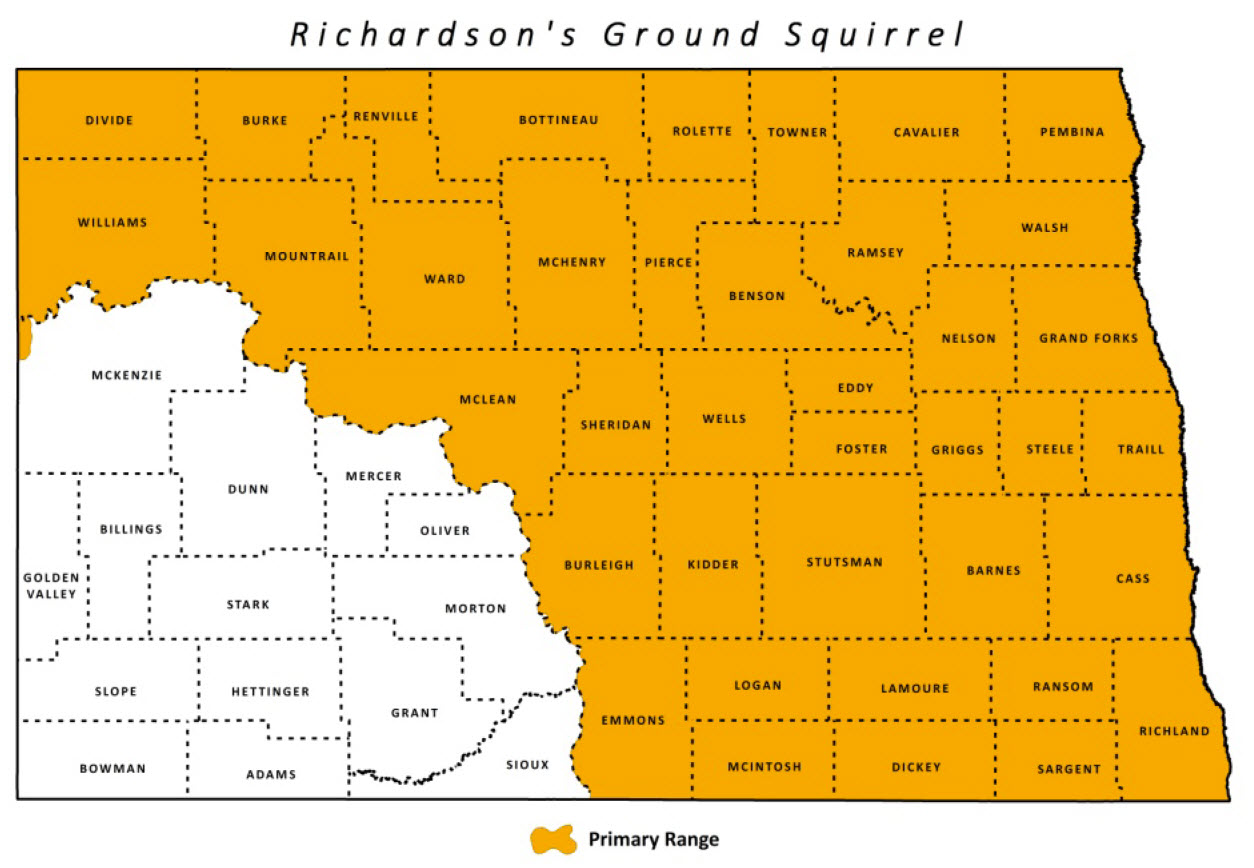
Richardson’s Ground Squirrel
| Scientific Name | Urocitellus richardsonii |
|---|---|
| General Description | Large colony-dwelling ground squirrel. Pelage is a mixture of buff and black hair on the back with a tan belly. |
| Status | Year-round resident. |
| Abundance | Locally Common. |
| Primary Habitat | Prefers native mixed-grass prairie. Commonly found in areas that are heavily grazed. |
| Federal Status | No federal status. |
| Reason for Designation | The Richardson’s Ground Squirrel serves much the same role as the Blacktailed Prairie Dog does in the western half of the state. Many species, including other species of conservation priority rely on Richardson’s Ground Squirrels for food and shelter. There is some indication of a decline within the state. This, coupled with a lack of information on the species, makes them a conservation priority. |
Locations and Conditions of Key Habitat
Preferred Habitat
A colonial species, Richardson’s Ground Squirrels prefer intact blocks of rangeland. Well grazed pastures of native or tame grass in areas of sandy loam or gravelly soils offer the best conditions for burrowing. Areas near agricultural fields are also preferred, as cereal grain is used as a food source.
Key Areas and Conditions for Richardson’s Ground Squirrel in North Dakota
Richardson’s Ground Squirrels are found only east of the Missouri River in North Dakota. Portions of Mclean, McHenry, Pierce, Eddy, and Foster counties are key areas for this species because of their larger tracts of intact prairie.
Problems Which May Affect this Species
Habitat
Conversion of native prairie and rangeland to agricultural lands is the leading threat to the Richardson’s Ground Squirrel.
Other Natural or Manmade Factors
Poisoning to control and eradicate colonies is prevalent. Recreational shooting of Richardson’s Ground Squirrels may affect populations. Colonial mammals are susceptible to plague, although no documented cases are known in North Dakota.
Research and Survey Efforts
Current Research or Surveys
- No current research for this species is ongoing.
Previous Research or Surveys
- A distribution study was conducted by the Northern Prairie Wildlife Research Center in 2005.
- The U.S. Forest Service mapped Richardson’s Ground Squirrel colonies on the Sheyenne National Grasslands in 2002.
- Colonies were mapped by the USFS on the Sheyenne Grasslands in 2005-06.
- A reproduction study was conducted by the University of North Dakota in 1975.
Additional Research or Surveys Needed
Utilize developed monitoring protocol for this species.
Management Recommendations
- Protect native prairie where possible.
- Consider removal of dilapidated shelterbelts or stands of trees within grassland, particularly within 50 meters of grassland patches >100 ha.
- Implement grazing systems to benefit grassland species.
- Work cooperatively with state and federal agencies to develop BMP’s that promote use of fire.
- Control noxious weeds through biological and chemical methods.
- Use fire or other tools to prevent woody invasion of grassland.
- Work with state and federal agencies to enforce existing pesticide regulations.
- Coordinate with wind energy companies to minimize impacts to grasslands.
- Surveys to establish baseline information on Richardson’s Ground Squirrels.
Monitoring Plans
No monitoring plan is in place for Richardson’s Ground Squirrel. A random township survey method developed in a previous study could be used to accomplish this.
2005-2015 Progress
The Richardson’s Ground Squirrel maintains a Level II on the Species of Conservation Priority list. Initial surveys were done in SWG T-3-1 Distribution of Richardson’s Ground Squirrel Colonies in North Dakota and Burrowing Owl Use of the Ground Squirrel Colonies. Follow-up work is needed to monitor this species.

Note: A listing of works consulted when compiling the information on this page may be found in the 2015 State Wildlife Action Plan.
